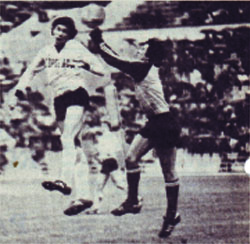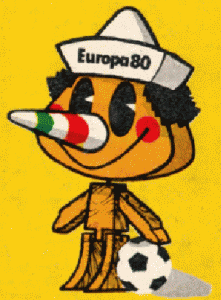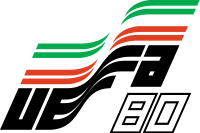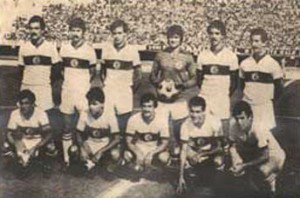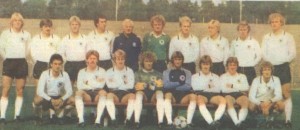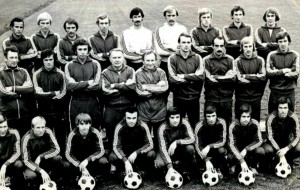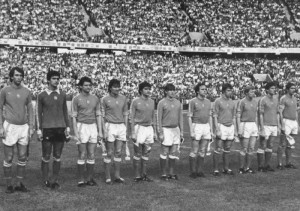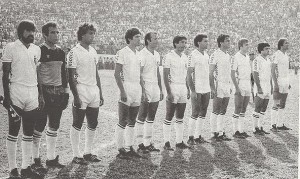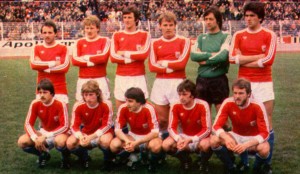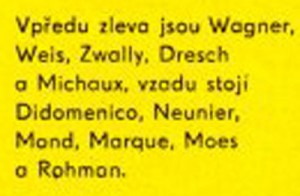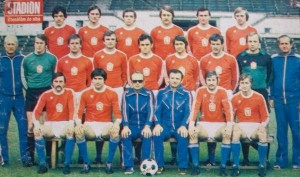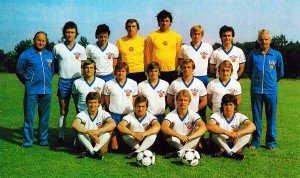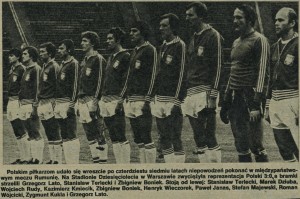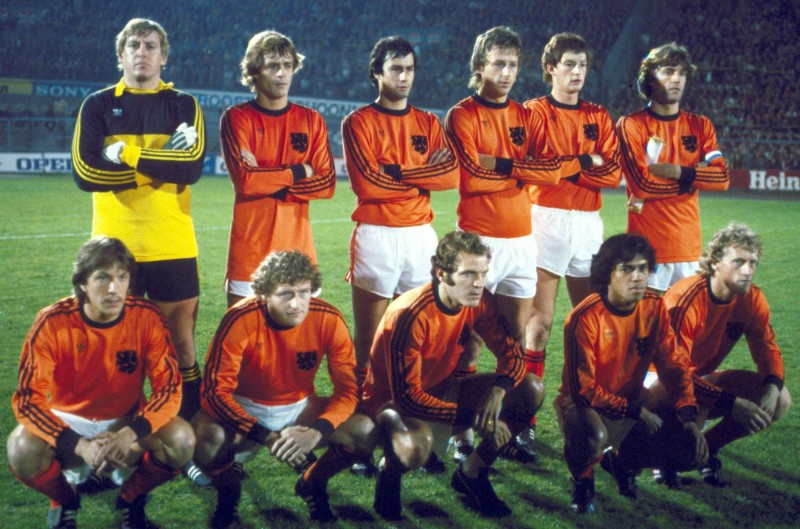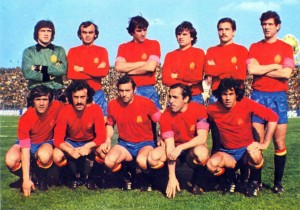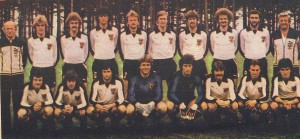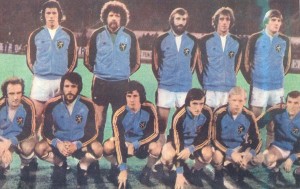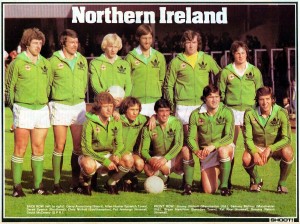Group A was the easier, but more puzzling group. West Germany and Holland were the favourites, yet, the pros and cons were many. As arbitrary as it is, let’s start with Holland. Strong at the 1978 World Cup, but not good enough to win. Very experienced squad, but lacking the quality of Cruijff’s era. The key figures were dangerously aging and there were no replacements of similar class. The team’s play became more physical and lacking the flair of the original ‘flying Dutchmen’, but they were tough and concentrated when needed: they had problems in the qualification group, but when it mattered most delivered, beating DDR as visitors in the very last group match and thus winning the group. Ruud Krol, the team’s captain, was very critical of the team, saying to France Football that he does not see any chance for Holland. West Germany and Czechoslovakia he considered stronger and Holland lacked quality players. Many considered his opinion typically Dutch underapreciation of their own. Many considered Holland prime favourite. But still not overwhelming one: Jan Zwartkruis was good coach, but he was replaced for the World Cup finals and success came with temporary big name – Happel. The same tactic as in 1974, when Michels was brought for the finals. Curiously, the Dutch did not change the coach for 1976 European finals and repeated the same in 1980. In 1976 they failed… There was also the old problem with pigheaded players, who often refused to play for the national team – quarrels and refusals were old story, so Holland hardly ever had the best team at hand. This time the problem was relatively small, but still existed: Neeskens refused to come back from USA for the finals. Arie Haan, however, accepted to join the team in which he was not to be a key figure as he was in 1978. Zwartkruis included many little known players – as much as risky experiment as it was a testimony of the short pool of talent. But the squad had enough class, plenty of experience, and had strong collective approach which compensated for evident shortage of superstars in 1978. It was high time for Holland to win something – perhaps this was the time, considering that the group was weaker and West Germany had perhaps more problems than Holland. And Krol, somewhat contradicting himself, spoke that it is time for revenge.
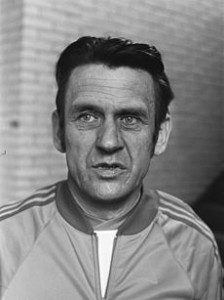 Jan Zwartkruis was at the helm of the team since 1976 – he shaped the team as he wanted. As he wanted to a point: he never got what he really wanted. Players whims plus the strong pressure from the leading clubs, which always argued against the needs of the national team, reduced his options for preparing the squad. Friendlies were particularly lacking and when they were scheduled, then key players were not available. But he adjusted to the circumstances and managed to qualify the team to two consecutive finals. This time he was not to be replaced for the real thing – a comfortable situation.
Jan Zwartkruis was at the helm of the team since 1976 – he shaped the team as he wanted. As he wanted to a point: he never got what he really wanted. Players whims plus the strong pressure from the leading clubs, which always argued against the needs of the national team, reduced his options for preparing the squad. Friendlies were particularly lacking and when they were scheduled, then key players were not available. But he adjusted to the circumstances and managed to qualify the team to two consecutive finals. This time he was not to be replaced for the real thing – a comfortable situation.
1
GK
Piet Schrijvers
(1946-12-15)15 December 1946 (aged 33)
32
Ajax
2
DF
Ben Wijnstekers
(1955-08-31) (aged 24)
4
Feyenoord
3
DF
Michel van de Korput
(1956-09-18) (aged 23)
3
Feyenoord
4
DF
Hugo Hovenkamp
(1950-10-05)(aged 29)
18
AZ
5
DF
Ruud Krol (c)
(1949-03-24)(aged 31)
72
Vancouver Whitecaps
6
DF
Jan Poortvliet
(1955-09-21) (aged 24)
15
PSV
7
FW
René van de Kerkhof
(1951-09-16) (aged 28)
36
PSV
8
FW
Willy van de Kerkhof
(1951-09-16) (aged 28)
36
PSV
9
FW
Kees Kist
(1952-08-07)(aged 27)
16
AZ
10
MF
Arie Haan
(1948-11-16) (aged 31)
32
Anderlecht
11
MF
Heini Otto
(1954-08-24)(aged 25)
1
Twente Enschede
12
FW
Johnny Rep
(1951-11-25) (aged 28)
35
Saint-Étienne
13
MF
Dick Nanninga
(1949-01-17)aged 31)
11
Roda Kerkrade
14
MF
Adrie Koster
(1954-11-18) (aged 25)
3
PSV
15
DF
Huub Stevens
(1953-11-29) (aged 26)
10
PSV
16
GK
Pim Doesburg
(1943-10-28)(aged 36)
3
Sparta Rotterdam
17
FW
Martien Vreijsen
(1955-11-15) (aged 24)
0
NAC Breda
18
MF
Frans Thijssen
(1952-01-23) (aged 28)
7
Ipswich Town
19
MF
Romeo Zondervan
(1959-03-03)(aged 21)
0
Twente Enschede
20
GK
Hans van Breukelen
(1956-10-04) (aged 23)
0
Utrecht
21
DF
Ernie Brandts
(1956-02-03)aged 24)
17
PSV
22
DF
John Metgod
(1958-02-27) (aged 22)
7
AZ
Third row: Vreijsen, Thijssen, Schrijvers, Stevens, Hovenkamp,Wijnstekers.
Middle row: Zondervan, van de Korput, Rep, Doesburg, Krol, Poortvliet, assistant coach Baan, coach Zwartkruis.
Sitting: Willie van de Kerkhof, Haan, Rene van de Kerkhof, Van Breukelen, Nanninga, Kist, Koster, Brandts.
A curious selection: on one hand, this was aging team, based on the stars of 1974 – 6 of the great team were here. But Schrijvers and van de Kerkhof twins were reserves back then. The other three were aging and by 1980 only Ruud Krol was world class. Rep was fading away and Haan was somewhat underapreciated. Even Krol was perhaps doubted by now: at 31, he just moved to play abroad and it was not one the big Spanish, German, or English clubs, but the Canadian Vancouver Whitecaps. Going to NASL was a sign of nearing the end. Zwartkruis also used players from 1978 – Nanninga and Brandts were heroes back than ,but the first was accidental hero and not a real star. He was 31 years old – hardly in his prime. Brandts unfortunately went downhill since the World Cup and it was already clear that he was not to be a great star. Hovenkamp, who left the team just before the finals in 1978 was back – this time a regular. Haan was to be a sustitute too, a sign his days were over – at least in the national team. The goalkeeping problem was painfully familiar – no classy keeper. Schrijvers was number one, and Doesburg – his back up. At 36, Doesburg had played only 3 matches for Holland… The third goalie was unheard of and was to remain so, for he was just making the numbers: Hans van Breukelen. Given his illustrious career and success later in the 1980s, one can guess that the talent was there already – but apparently Zwartkruis did not have the guts for taking a risk with youngster playing for lowly Utrecht. So far, van Breukelen had 0 matches for Holland – as well as Zondervan and Vreijsen. Seven players had less than 10 matches for the national team, some of them starters. And that in the most experienced and old team at the finals! It was not entirely clear what Zwartkruis wanted – the team was clearly based on Krol, which was fine since he was perhaps the best in the world at the moment and capable of much more than defending. But Haan – always reliable, Thijssen – in great form and key player of Ipswich Town at its best, Kist – the top European goalscorer, and van de Kerkhof twins – still the top Dutch midfielders, were not regulars. It looked like Zwartkruis wanted a physical, collective-minded team, spurred and influenced by Krol, and depending heavily on Rep to finish the attacks. Did not look great, but there was not much to say against such approach either – it was more than possible to reach the final and then whatever happens. Contrary to the photo above, there were no players using individual kits this time. As ever before, there were players not included who knows why – Tahamata (Ajax), for instance.
